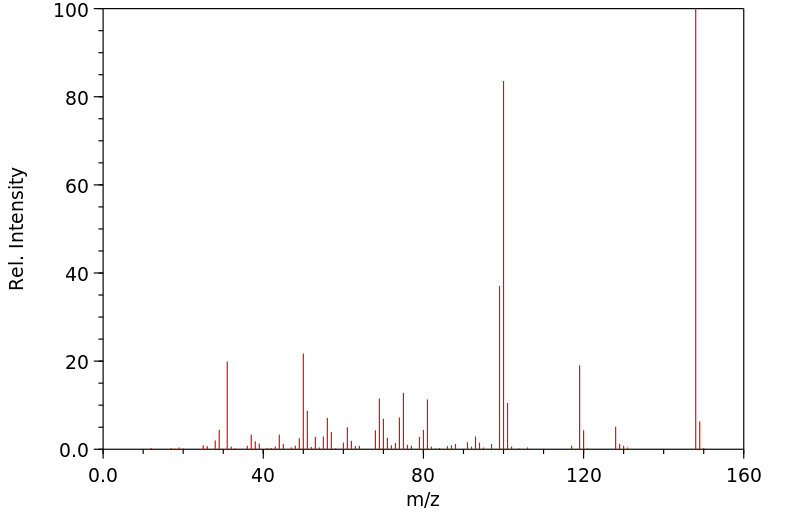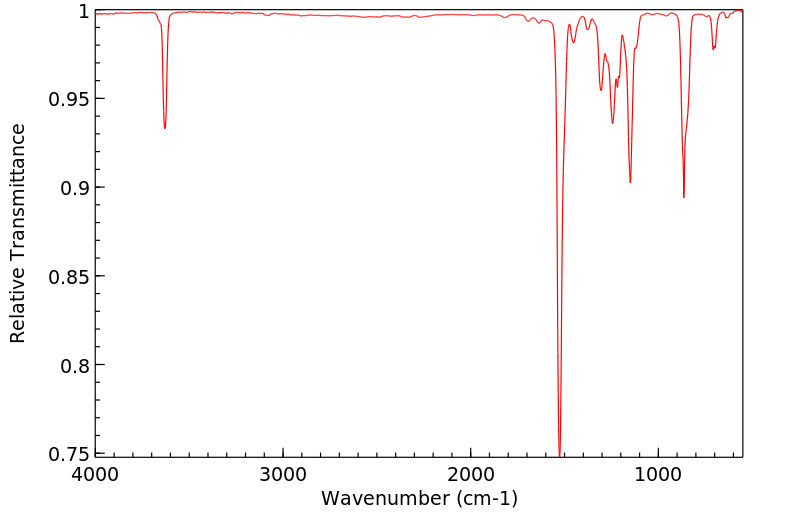2,4,5-三氟苯酚 | 2268-16-8
中文名称
2,4,5-三氟苯酚
中文别名
2,4,5-三氟代苯酚
英文名称
2,4,5-trifluorophenol
英文别名
——
CAS
2268-16-8
化学式
C6H3F3O
mdl
MFCD00061215
分子量
148.084
InChiKey
ODGMYCITQAIRCI-UHFFFAOYSA-N
BEILSTEIN
——
EINECS
——
-
物化性质
-
计算性质
-
ADMET
-
安全信息
-
SDS
-
制备方法与用途
-
上下游信息
-
文献信息
-
表征谱图
-
同类化合物
-
相关功能分类
-
相关结构分类
物化性质
-
熔点:37-42 °C
-
沸点:57 C
-
密度:1.4585 (estimate)
-
闪点:54 °C
-
稳定性/保质期:
避免让氧化物接触。
计算性质
-
辛醇/水分配系数(LogP):1.9
-
重原子数:10
-
可旋转键数:0
-
环数:1.0
-
sp3杂化的碳原子比例:0.0
-
拓扑面积:20.2
-
氢给体数:1
-
氢受体数:4
安全信息
-
危险等级:4.1
-
危险品标志:F,Xi,C
-
安全说明:S16,S26,S36/37/39,S45
-
危险类别码:R20/21/22,R34,R36/37/38,R11
-
海关编码:29081000
-
危险品运输编号:1993
-
包装等级:III
-
危险类别:4.1
-
危险性防范说明:P264,P270,P271,P280,P304+P340,P305+P351+P338,P310,P330,P331,P363,P370+P378,P403,P501
-
危险性描述:H228,H302+H312+H332,H314
-
储存条件:将容器密封后,放入一个紧密封装的储存器中,并存放在阴凉、干燥的地方。
SDS
| Name: | 2 4 5-Trifluorophenol 98% Material Safety Data Sheet |
| Synonym: | None Known |
| CAS: | 2268-16-8 |
Synonym:None Known
Section 2 - COMPOSITION, INFORMATION ON INGREDIENTS
| CAS# | Chemical Name | content | EINECS# |
| 2268-16-8 | 2,4,5-Trifluorophenol | 98% | unlisted |
Risk Phrases: 10 20/21/22 36/37/38
Section 3 - HAZARDS IDENTIFICATION
EMERGENCY OVERVIEW
Flammable. Harmful by inhalation, in contact with skin and if swallowed. Irritating to eyes, respiratory system and skin.Hygroscopic (absorbs moisture from the air).
Potential Health Effects
Eye:
Causes eye irritation. May cause chemical conjunctivitis and corneal damage.
Skin:
Causes skin irritation. May be harmful if absorbed through the skin.
May cause cyanosis of the extremities.
Ingestion:
May cause gastrointestinal irritation with nausea, vomiting and diarrhea. The toxicological properties of this substance have not been fully investigated. Ingestion of large amounts may cause CNS depression. May be harmful if swallowed.
Inhalation:
Causes respiratory tract irritation. Aspiration may lead to pulmonary edema. May be harmful if inhaled. Vapors may cause dizziness or suffocation. May cause burning sensation in the chest.
Chronic:
Effects may be delayed.
Section 4 - FIRST AID MEASURES
Eyes: Immediately flush eyes with plenty of water for at least 15 minutes, occasionally lifting the upper and lower eyelids. Get medical aid.
Skin:
Get medical aid. Flush skin with plenty of water for at least 15 minutes while removing contaminated clothing and shoes. Wash clothing before reuse.
Ingestion:
Never give anything by mouth to an unconscious person. Get medical aid. Do NOT induce vomiting. If conscious and alert, rinse mouth and drink 2-4 cupfuls of milk or water. Wash mouth out with water.
Inhalation:
Remove from exposure and move to fresh air immediately. If not breathing, give artificial respiration. If breathing is difficult, give oxygen. Get medical aid. Do NOT use mouth-to-mouth resuscitation.
Notes to Physician:
Treat symptomatically and supportively.
Section 5 - FIRE FIGHTING MEASURES
General Information:
As in any fire, wear a self-contained breathing apparatus in pressure-demand, MSHA/NIOSH (approved or equivalent), and full protective gear. Vapors may form an explosive mixture with air.
Vapors can travel to a source of ignition and flash back. During a fire, irritating and highly toxic gases may be generated by thermal decomposition or combustion. Will burn if involved in a fire. Use water spray to keep fire-exposed containers cool. Containers may explode in the heat of a fire. Flammable liquid and vapor. Runoff from fire control or dilution water may cause pollution.
Extinguishing Media:
For small fires, use dry chemical, carbon dioxide, water spray or alcohol-resistant foam. For large fires, use water spray, fog, or alcohol-resistant foam. Use water spray to cool fire-exposed containers. Water may be ineffective. Do NOT use straight streams of water.
Section 6 - ACCIDENTAL RELEASE MEASURES
General Information: Use proper personal protective equipment as indicated in Section 8.
Spills/Leaks:
Absorb spill with inert material (e.g. vermiculite, sand or earth), then place in suitable container. Avoid runoff into storm sewers and ditches which lead to waterways. Clean up spills immediately, observing precautions in the Protective Equipment section. Remove all sources of ignition. Use a spark-proof tool. Provide ventilation. A vapor suppressing foam may be used to reduce vapors.
Section 7 - HANDLING and STORAGE
Handling:
Ground and bond containers when transferring material. Use spark-proof tools and explosion proof equipment. Avoid breathing dust, vapor, mist, or gas. Avoid contact with eyes, skin, and clothing. Avoid contact with skin and eyes. Empty containers retain product residue, (liquid and/or vapor), and can be dangerous. Keep container tightly closed. Keep away from heat, sparks and flame.
Avoid ingestion and inhalation. Use with adequate ventilation. Wash clothing before reuse. Do not pressurize, cut, weld, braze, solder, drill, grind, or expose empty containers to heat, sparks or open flames.
Storage:
Keep away from sources of ignition. Store in a tightly closed container. Flammables-area. Store protected from moisture. Store in a cool, dry area away from incompatible substances.
Section 8 - EXPOSURE CONTROLS, PERSONAL PROTECTION
Engineering Controls:
Facilities storing or utilizing this material should be equipped with an eyewash facility and a safety shower. Use adequate ventilation to keep airborne concentrations low.
Exposure Limits CAS# 2268-16-8: Personal Protective Equipment Eyes: Wear appropriate protective eyeglasses or chemical safety goggles as described by OSHA's eye and face protection regulations in 29 CFR 1910.133 or European Standard EN166.
Skin:
Wear appropriate protective gloves to prevent skin exposure.
Clothing:
Wear appropriate protective clothing to prevent skin exposure.
Respirators:
Follow the OSHA respirator regulations found in 29 CFR 1910.134 or European Standard EN 149. Use a NIOSH/MSHA or European Standard EN 149 approved respirator if exposure limits are exceeded or if irritation or other symptoms are experienced.
Section 9 - PHYSICAL AND CHEMICAL PROPERTIES
Physical State: Solid
Color: white
Odor: Not available.
pH: Not available.
Vapor Pressure: Not available.
Viscosity: Not available.
Boiling Point: Not available.
Freezing/Melting Point: 39 - 42 deg C
Autoignition Temperature: Not available.
Flash Point: 54 deg C ( 129.20 deg F)
Explosion Limits, lower: Not available.
Explosion Limits, upper: Not available.
Decomposition Temperature:
Solubility in water:
Specific Gravity/Density:
Molecular Formula: F3C6H2OH
Molecular Weight: 148.09
Section 10 - STABILITY AND REACTIVITY
Chemical Stability:
Stable at room temperature in closed containers under normal storage and handling conditions.
Conditions to Avoid:
Incompatible materials, ignition sources, excess heat, exposure to moist air or water.
Incompatibilities with Other Materials:
Moisture, oxidizing agents.
Hazardous Decomposition Products:
Carbon monoxide, carbon dioxide, hydrogen fluoride gas.
Hazardous Polymerization: Has not been reported
Section 11 - TOXICOLOGICAL INFORMATION
RTECS#:
CAS# 2268-16-8 unlisted.
LD50/LC50:
Not available.
Carcinogenicity:
2,4,5-Trifluorophenol - Not listed by ACGIH, IARC, or NTP.
Section 12 - ECOLOGICAL INFORMATION
Section 13 - DISPOSAL CONSIDERATIONS
Dispose of in a manner consistent with federal, state, and local regulations.
Section 14 - TRANSPORT INFORMATION
IATA
Shipping Name: FLAMMABLE LIQUID, N.O.S.*
Hazard Class: 3
UN Number: 1993
Packing Group: III
IMO
Shipping Name: FLAMMABLE LIQUID, N.O.S.
Hazard Class: 3.3
UN Number: 1993
Packing Group: III
RID/ADR
Shipping Name: FLAMMABLE LIQUID, N.O.S.
Hazard Class: 3
UN Number: 1993
Packing group: III
Section 15 - REGULATORY INFORMATION
European/International Regulations
European Labeling in Accordance with EC Directives
Hazard Symbols: XN
Risk Phrases:
R 10 Flammable.
R 20/21/22 Harmful by inhalation, in contact with
skin and if swallowed.
R 36/37/38 Irritating to eyes, respiratory system
and skin.
Safety Phrases:
S 9 Keep container in a well-ventilated place.
S 16 Keep away from sources of ignition - No
smoking.
S 26 In case of contact with eyes, rinse immediately
with plenty of water and seek medical advice.
S 33 Take precautionary measures against static
discharges.
S 37/39 Wear suitable gloves and eye/face
protection.
WGK (Water Danger/Protection)
CAS# 2268-16-8: No information available.
Canada
None of the chemicals in this product are listed on the DSL/NDSL list.
CAS# 2268-16-8 is not listed on Canada's Ingredient Disclosure List.
US FEDERAL
TSCA
CAS# 2268-16-8 is not listed on the TSCA inventory.
It is for research and development use only.
SECTION 16 - ADDITIONAL INFORMATION
N/A
上下游信息
-
下游产品
中文名称 英文名称 CAS号 化学式 分子量 2,4,5-三氟苯甲醚 2,4,5-Trifluoroanisole 5006-38-2 C7H5F3O 162.111 1-(3-溴-丙氧基)-2,4,5-三氟-苯 1-(3-Bromopropoxy)-2,4,5-trifluorobenzene 1026393-96-3 C9H8BrF3O 269.061 —— 3-(2,4,5-trifluoro-phenoxy)-propionic acid 2267-67-6 C9H7F3O3 220.148
反应信息
-
作为反应物:描述:2,4,5-三氟苯酚 在 sodium hydroxide 、 四丁基硫酸氢铵 作用下, 以 乙二醇甲醚 为溶剂, 反应 46.0h, 生成 N-[3-(2,4,5-trifluorophenoxy)propoxy]acetamide参考文献:名称:Phenoxypropoxybiguanides, Prodrugs of DHFR−Inhibiting Diaminotriazine Antimalarials摘要:A total of 34 analogues of the biguanide PS-15 (5s), a prodrug of the diaminotriazine WR99210 (8s), have been prepared. Several of them, such as 5b (PS-33) and 5m. (PS-26), maintain or exceed the in vivo activity of PS-15 while not requiring the use of highly regulated starting materials. The putative diaminotriazine metabolites of these new analogues (compounds 8) have also been prepared and shown to maintain the activity against resistant P. falciparum strains. The structure-activity relationships of biguanides 5 and putative metabolites 8 are discussed.DOI:10.1021/jm010089z
-
作为产物:描述:参考文献:名称:Allen, Kim J.; Bolton, Roger; Williams, Gareth H., Journal of the Chemical Society. Perkin transactions II, 1983, p. 691 - 696摘要:DOI:
文献信息
-
可用作皮质儿茶酚胺能神经传递调节剂的新型氮杂环丁烷衍生物申请人:综合研究实验室瑞典股份公司公开号:CN109963834B公开(公告)日:2023-04-14本发明提供了一种药物组合物,其包含:治疗有效量的式(I)的化合物、或其同位素标记的类似物、或其药学上可接受的盐,其中:R1、R2、R3、R6和R7各自表示H或F,R4表示H或CH3,R5表示H或C1‑C4烷基,其中R1、R2、R3、R6和R7中的至少两个表示F;以及至少一种药学上可接受的载体、赋形剂和/或稀释剂。
-
Identification of Anthranilic Acid Derivatives as a Novel Class of Allosteric Inhibitors of Hepatitis C NS5B Polymerase作者:Thomas Nittoli、Kevin Curran、Shabana Insaf、Martin DiGrandi、Mark Orlowski、Rajiv Chopra、Atul Agarwal、Anita Y. M. Howe、Amar Prashad、M. Brawner Floyd、Bernard Johnson、Alan Sutherland、Karen Wheless、Boris Feld、John O'Connell、Tarek S. Mansour、Jonathan BloomDOI:10.1021/jm061428x日期:2007.5.1A series of potent anthranilic acid-based inhibitors of the hepatitis C NS5B polymerase has been identified. The inhibitors bind to a site on NS5B between the thumb and palm regions adjacent to the active site as determined by X-ray crystallography of the enzyme-inhibitor complex. Guided by both molecular modeling and traditional SAR, the enzyme activity of the initial hit was improved by approximately
-
一种多氟代二苯并对二噁英的制备方法
-
[EN] NOVEL PIPERAZINYL-PYRAZINONE DERIVATIVES FOR THE TREATMENT OF 5-HT2A RECEPTOR-RELATED DISORDERS<br/>[FR] NOUVEAUX DERIVES DE PIPERAZINYL-PYRAZINONE POUR LE TRAITEMENT DES TROUBLES LIES AU RECEPTEUR 5-HT2A申请人:BIOVITRUM AB公开号:WO2004009586A1公开(公告)日:2004-01-29Compounds of the general formula (I): (I)wherein m, n, R1, R2, R3 and R4 are as described in the specification. Further included are pharmaceutical compositions comprising the compounds, processes for their preparation, as well as the use of the compounds for the preparation of a medicament for the treatment of 5-HT2A receptor-related disorders or medical conditions.通式(I)的化合物:(I)其中m、n、R1、R2、R3和R4如规范中所述。还包括包含这些化合物的药物组合物,它们的制备方法,以及利用这些化合物制备用于治疗5-HT2A受体相关疾病或医疗状况的药物的用途。
-
GPR119 Receptor Agonists申请人:Erickson Shawn David公开号:US20090286812A1公开(公告)日:2009-11-19Provided herein are compounds of the formula (I): as well as pharmaceutically acceptable salts thereof, wherein the substituents are as those disclosed in the specification. These compounds, and the pharmaceutical compositions containing them, are useful for the treatment of metabolic diseases and disorders such as, for example, type II diabetes mellitus.提供以下公式(I)的化合物: 以及可药用的接受盐,其中取代基如说明书中所披露。这些化合物以及含有它们的药物组合物可用于治疗代谢性疾病和障碍,例如,2型糖尿病。
表征谱图
-
氢谱1HNMR
-
质谱MS
-
碳谱13CNMR
-
红外IR
-
拉曼Raman
-
峰位数据
-
峰位匹配
-
表征信息
同类化合物
(2-氯-6-羟基苯基)硼酸
黄柄曲菌素
高香草酸-d3
高香草酸-13C6
高香草酸
高香兰酸乙酯
高辣椒素II
高二氢辣椒素I
香草醛醛肟
香草醛苯腙
香草醛-甲氧基-13C
香草醛-(N-对甲苯基肟)
香草醛
香草酸肼
香草壬酰胺
香草基扁桃酸乙酯
香草吗啉
香草二乙胺
香兰素胺硬脂酸盐
香兰素胺硬脂酸盐
香兰素胺盐酸盐
香兰素丙二醇缩醛
香兰素13C6
香兰素-D3
香兰基乙基醚
香兰基丁醚
顺式-5-正十五碳-8'-烯基间苯二酚
顺式-1-(2-羟基-5-甲基苯基)-2-丁烯-1-酮
顺式-1-(2-羟基-4-甲氧基苯基)-2-丁烯-1-酮
顺-3-氯二氢-5-苯基呋喃-2(3H)-酮
雌二醇杂质1
降二氢辣椒碱
阿诺洛尔
阿瓦醇
阿普斯特杂质
间苯二酚双(二苯基磷酸酯)
间苯二酚-烯丙醇聚合物
间苯二酚-D6
间苯二酚
间苯三酚甲醛
间苯三酚二水合物
间苯三酚
间羟基苯乙基溴
间硝基苯酚
间甲酚紫钠盐
间甲酚与对甲酚和苯酚甲醛树脂的聚合物
间甲酚-D7
间甲酚-D3
间甲酚
间溴苯酚








